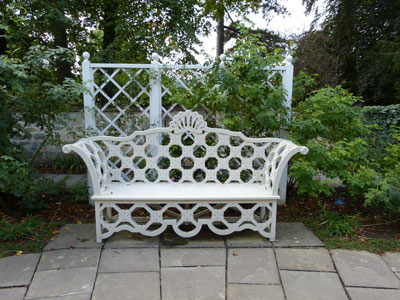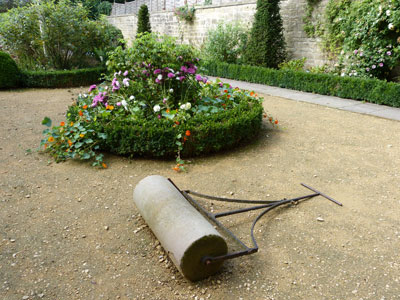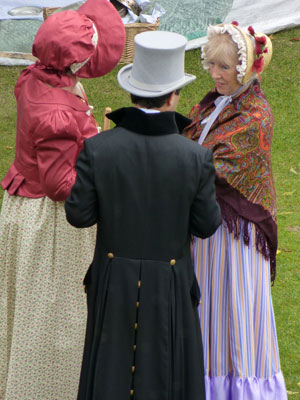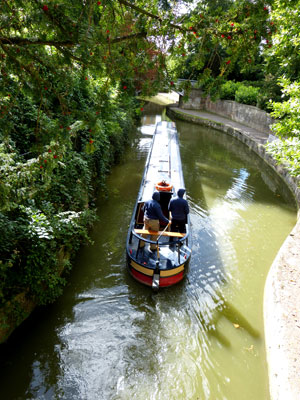Invoking Jane Austen
This item appears on page 60 of the May 2014 issue.
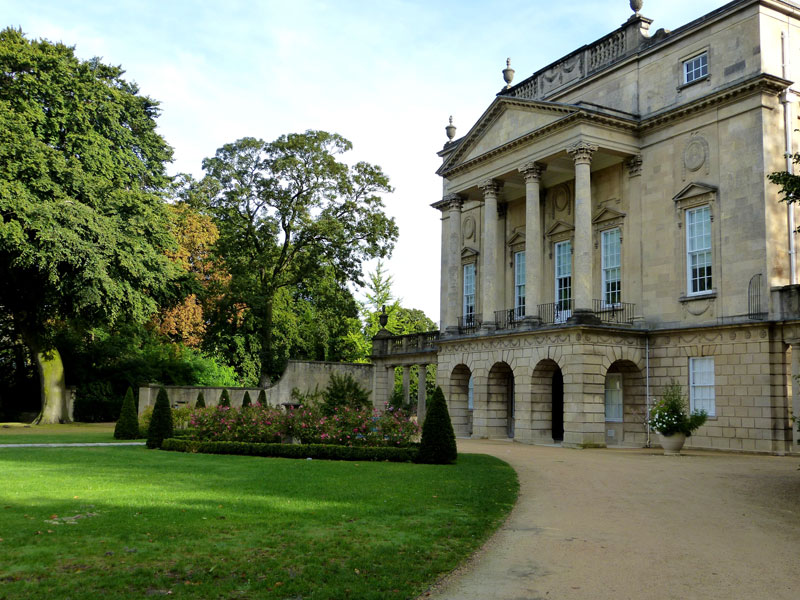
Bath was awash in Jane Austen character look-alikes. Hundreds of Mr. Darcys and Mrs. Bennets filled the sidewalks of this patrician small city in homage to her for having lived and written there for five years. It was Bath’s annual Jane Austen Festival (in 2014 taking place Sept. 12-21) and I, alas, not a Jane Austen fan, had unwittingly blundered into its midst for a 3-day stay.
“Oh, who could be bored with Bath?” cried Catherine Morland, the ever-optimistic heroine of Austen’s “Northanger Abbey.” Well, Jane Austen for one, who, with her customary caustic wit, privately claimed to have happily escaped the place (bad climate, silly social life, and Bath’s famous Sally Lunn buns gave her indigestion). No matter, it appeared that to the city’s bonneted and waistcoated visitors this week, Bath, England, was Austen mecca.
Rather than take on the impossibility of ignoring the festival, I decided to go along with it and signed up for a Jane Austen walk that, to my delight, led to the discovery of two gardens, gardens with tie-ins to Jane Austen though not eye-rollingly so to a non-Jane Austen fan.
18th-century garden
A leafy path known as the Gravel Walk, albeit now paved, follows the backyard curve of a section of the Circus, the elegant circle of Georgian-era Palladian townhouses overlooking the city. Captain Wentworth and Anne Elliot of Austen’s novel “Persuasion,” finally reconciled and deeply engrossed in each other’s presence, walked this path.
Today, similarly engrossed, it would be easy to miss a small green door in the brick wall marking the Circus’ edge. Pushed open, it reveals a remarkable survivor of a Georgian-era walled garden, one appropriately called the Georgian Garden.
Excavations by the Bath Archaeological Trust in 1985 revealed that the original garden had no lawn but was instead surfaced with a mix of gravel and clay, deemed much kinder to the fashionable fabric shoes of the day than wet grass. A period roller placed in the garden reminds that, while practical, the surface was not maintenance free.
Defined by the property’s walled edges, the garden is a simple rectangle, its landscaping design deliberately geometric so as to afford a pleasing design when viewed from the upper windows of the house.
Shrubs and flowers available in the 18th century fill the garden’s side beds and circular areas, all edged neatly in boxwood. At the bottom of the garden, a bench invites lingering — Jane Austen novel in hand? — in quiet seclusion.
Behind the bench, a flight of steps, added around 1770, gives access to the, then, newly created Gravel Walk and, on this day, a whole new parade of Austen character look-alikes.
Historic park
The second garden, Sydney Gardens, is Bath’s oldest park.
Designed in 1795 as a commercial pleasure garden, its 12-acre expanse of lawns, trees, shrubs and flower-filled spaces quickly became the place to stroll and be seen while enjoying such enhancements as a sham castle, maze, grotto, thatched pavilions, swings and a “mill scene” represented on canvas. All had disappeared by 1840.
In 1891, the original 99-year lease of Sydney Gardens expired and the pleasure grounds were sold. The site was bought by the Bath City Council in 1908 and reopened to the public as a city park in 1913.
The gardens were reached via the entrance gate to the elegant Sydney Tavern, now the Holburne Museum of Art, home to fine and decorative art.
In 1801 the Austen family took lodgings at No. 4, Sydney Place, directly across from the Sydney Tavern.
“There is to be a grand gala on Tuesday evening in Sydney Gardens,” Jane wrote to her sister, Cassandra, “a concert with fireworks. The concert will have more than its usual charm for me, as the gardens are large enough for me to get pretty well beyond the reach of its sound.”
Today, in contrast to the quiet, tucked-away confines of the walled Georgian Garden, the expansive acreage of greenery and flower beds at the end of Great Pulteney Street is perpetually busy with joggers on morning runs, mums pushing prams, dogs chasing balls, and elderly souls taking in a drift of sun from a path-side bench.
A canal divides the garden in half, part of the Kennet and Avon Canal constructed between 1796 and 1810 connecting Bristol with London. It was no sooner finished than it was obsolete; steam engines were providing a faster and more efficient mode of transportation across the landscape. Sunk low between stone embankments, the canal does not obstruct sweeping views of the park.
Following a path, I was surprised to come upon what is today a charming, unexpected, picturesque feature of the garden. While sturdy stone bridges were constructed to carry carriages around the perimeter of the garden, elegant iron bridges “in the manner of the Chinese” were built for cross-canal foot traffic. Today they offer a stopping place to watch swans drift by and to wave at passengers aboard the occasional excursion boat making its way down the winding, tree-shaded canal.
Before leaving the garden, note the Holburne Museum’s tearoom, with garden seating on fine days, which provides an opportunity to sample Bath’s famous Sally Lunn buns. . . hopefully without a touch of indigestion.
Visiting Bath
A visit to The Roman Baths (Stall Street, Bath, England, BA1 1LZ, U.K.; phone +44 [0] 1225 477785) is a Bath “must do.” Opting for an audio guide, as I did on my visit last year, brings the baths and the entire Roman era to life with descriptions, sounds and stories.
Plan on staying at least three hours, becoming immersed in what I consider one of the best historic tourist attractions I’ve ever visited. The baths are open daily except Dec. 25 and 26. General admission costs £13.50 (near $22.50) adult, £11.75 senior or £8.80 child.
While Bath is a most walkable city, I first hopped aboard City Sightseeing Bath’s hop-on, hop-off buses (www.city-sightseeing.com) for an overview. Two routes are offered: a “City Tour” and a “Skyline Tour.” Tickets (£14 adult or £8 child) can be purchased on board, are good for 24 hours and include both routes.
I also hopped aboard a Pulteney Cruisers boat (phone +44 1225 312900, www.bathboating.com) for an entirely different sightseeing experience: a one-hour scenic excursion on the Avon River from the city center into the countryside. Four boats leave at frequent intervals during the day. No tickets; you pay on board — £8 ($13.25) adult or £6 senior.
For info on visiting Bath, contact the Bath Visitor Information Centre (Abbey Chambers, Abbey Churchyard, Bath, England, BA1 1LY, U.K.; phone, in the UK, 0906 711 2000 [50p/min.] or, from overseas, +44 [0] 844 847 5257 or go to visitbath.co.uk and click on “Visitor Information Centre”).

